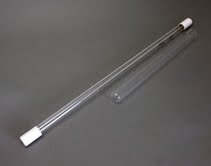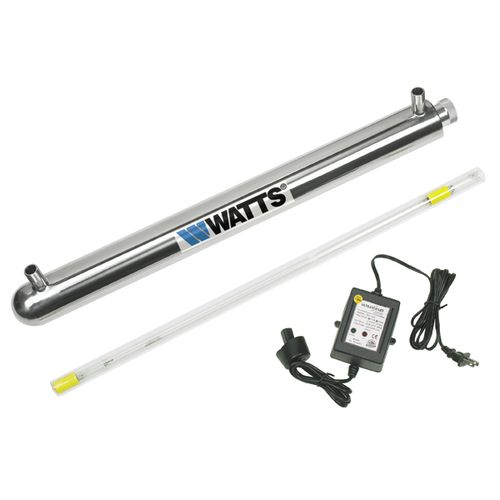
An Email Publication About Water and Water Treatment
May 2011
An Email Publication About Water and Water Treatment May 2011 |
In this brand new Occasional you'll hear about fiberglass mineral tanks, the ten most endangered rivers, and a very bad oil leak in Ontario. There's also news about Starbucks, Kraft Foods, World Water Relief, National Public Gardens Day, and Druckbehalterverordung. Hear news of a very bad cholera outbreak in Cameroon, a spaying and neutering program for bacteria, the surprising water content of Catalpa and other trees, and a new method for removing phosphates from water with sugar beet wastes. Then there's the invasion of the spiny water flea, drinking water contamination with tritium from old nuclear weapons, and the discovery of UV disinfection. Learn about the quartz sleeve, LP mercury lamps, nanometers, megaJoules, and The Fleet. And, as always, much, much more. The Occasional is overseen by Pure Water Gazette editor Hardly Waite. To Read This Issue on Our Website
Chiefest is water of all things, for
streaming |
 |
While you were dancing around the Maypole, keeping an eye on the weather report, and waiting for the Rapture, a lot of important things happened in the world of water. To hear all about it, read on.Water News for May 2011Five cities have been selected as finalists in the U.S. Conference of Mayors' (USCM) 2011 Best Tasting City Water in America contest following the preliminary round of competition. "Our fair city," Denton, TX, is among them. More than 28,000 barrels of oil leaked from a pipeline in Northern Ontario. A marketing research report has revealed that ultraviolet technology is being more widely used by municipalities. "Conventional drinking water treatment plants are unable to remove specific contaminants like cryptosporidium, which makes UV a very attractive alternative." In spite of a lot of bad publicity for the bottled water industry, bottled water sales increased 3.5 percent in 2010.
There was more news about the questionable practice of marketing sewage sludge as organic compost. Maryland passed legislation to protect water by regulating the use of lawn fertilizers! Texas-based Mahard Egg Farm Inc. has agreed to pay a $1.9 million penalty to resolve Clean Water Act (CWA) violations at its egg production facilities in Texas and Oklahoma, Coke persisted in its effort to paint itself green, although Grist magazine asked: what can possibly be "green" about a business model geared to sucking in huge amounts of drinking water, blasting it with what are probably toxic sweeteners and other dodgy substances, and then packaging it in little aluminum cans and plastic bottles and sending them far and wide, to be chilled (using fossil energy) before consumption? Kraft Foods Inc. has agreed to pay $8.1 million to settle a class-action lawsuit over drinking water pollution caused by a former factory in Attica, IN. Radioactive
groundwater laced with the remnants of Cold War nuclear weapons testing is inching its way beyond the Nevada Test Site boundary,
where scientists expect to soon find it for the first time. The
concentration of tritium in area water is much higher than safe drinking water
guidelines.
The EPA is now maintaining ECHO, the Enforcement and Compliance History Outline, to allow citizens to check the compliance record of their local water supplier. Type in your Zip Code for a report. Contaminated drinking water in Cameroon resulting from flooding has caused a cholera outbreak that has killed 250. The Sierra Club has filed a lawsuit against coal company ICG Hazard, alleging that it violated federal water regulations by dumping toxic amounts of selenium in waterways near a mine in southeastern Kentucky. Two former Nevada water officials were arrested on charges of accepting $1.3 million in bribes. Two North Carolina city officials were arrested for falsifying waste water management records. The Texas legislature is tackling the tricky and touchy issue of who owns the groundwater beneath private property. See a great water picture by a University of Texas photographer. Investigators say the wrong-sized studs were used on a clamp that joined two giant water pipes, and this was likely the major reason for the massive May 2010 water main break that sent 265 million gallons of water and tons of soil into the nearby Charles River. University of Florida researchers have developed an efficient way to remove phosphate that results from fertilizers from water with "biochar," a natural product made from sugar beets wastes and weeds. Starbucks reduced water consumption by 21.6 percent over 2008 levels, nearing the goal 25 percent reduction it was shooting for. A Trenton, NJ water department employee was dismissed for absenteeism in spite of his claim that he was traumatized by witnessing a fellow employee urinating into the city water supply. (This is a strange story.) You can see our Pura UV units in action in Haiti on the World
Water Relief's interesting video and on their website. They've been
buying UV equipment from us for some time and we applaud their
accomplishments in Haiti.
Rain Gardens From the Austin publication, WaterWise E-News.
Rain gardens are a new design technique being used in Austin. They are intended to help slow down, divert, catch and filter some of the rainwater that falls on a site. They are best used in combination with other strategies designed to keep water on the land, including: swales, dry creek beds, berms, terracing, vegetative filter strips, and rainwater harvesting systems. For more information see the new Grow Green Rain Garden fact sheet.from an Austin publication. Water and Trees You've probably seen the charts that show how much water is contained in the makeup of everything from an orange to the human heart. Massive, solid trees are no different. Their mass is comprised of a significant amount of water. And like people, not all trees are equal in water content. The
Catalpa tree in my back yard, according to a chart supplied by the
National Computational Science Leadership Program, is, by weight,
48.25% water. Trees listed range from 7% to 54% water.
Ultraviolet 101
|
 |
|---|
| UV Lamp, on left, and a quartz sleeve (for a smaller unit). |
UV Dosage
UV
dosage is typically measured in units called "Joules," and
it is most frequently expressed in terms of "mega Joules per
square centimeter," or mJ/cm². (Microwatts per second per
square centimeter, expressed as µWs/cm2, and mJ/cm2 represent the
same dosage and the two systems are used interchangeably.) The higher the number, the
higher the dosage.
The UV dosage received by the water increases as the flow rate of the water decreases, so a UV unit that puts out a dosage of 16 mJ/cm² while treating water at a flow rate of eleven gallons per minute (gpm) will be rated as 40 mJ/cm² if the flow rate is decreased to 4.5 gpm.
Put another way, a UV system rated by its manufacturer to treat water at 40 mJ/cm² at 4.5 gpm will be delivering a dosage of 16 mJ/cm² even if the user exceeds the recommended limit and runs the water at eleven gpm.
The tendency now in UV dosage is to follow the
“more is
better” view we've all been indoctrinated in.
If ten nuclear bombs
will destroy the world, to be safe we need ten thousand. The
most common concerns, e Coli, Giardia, and Cryptosporidium, are
effectively eliminated at less than seven mJ/cm². The minimum dosage now recommended by NSF, however,
is 40 mJ/cm².
Factors That Affect UV Effectiveness
First, there is the age of the lamp. UV lamps lose strength with time, and almost all manufacturers assume a once-a-year replacement when they design their units. It is a mistake to believe that if the lamp is still burning all is well. UV lamps should be replaced once a year, and when replaced they should still be burning strong.
Then there is flow rate. The unit should be sized to provide adequate protection at the highest possible flow rates, but practicality should tell you that in most residential situations, most water is used at a couple of gallons per minute and a great deal of the time—most of the time, in fact—no water at all is being used.
Also a factor is general absorption of the UV light for unintended purposes. UV makers usually require that water have less than seven grains per gallon of hardness, less that 0.3 ppm iron, less than 0.05 ppm manganese, and that it be generally clear and free of particulate and tannins. All of these can create situations where the light is absorbed and, therefore, its anti-microbial activity is diminished. Hardness, for example, can form scale on the outside of the quartz sleeve which blocks the passage of light.
A related factor is called shadowing. It is primarily caused by particles in the water which can allow microbes to “hide” from the light and not receive adequate UV dosage. The commonly accepted practice in UV treatment is to put a sediment filter of 5 microns or less in front of the treatment chamber to screen out any particles that could allow shadowing. Even if the water looks perfectly clear to the eye, putting a five-micron filter in front of the UV unit is a good idea.
UV as a Germicidal Treatment.
Pros
and Cons
The good thing about UV is that in addition to being a very effective treatment for microbes, it is relatively simple and inexpensive to buy and to maintain. It adds no chemicals to the water and leaves no “by-products.” It is very safe, if you follow a couple of simple rules (like don't stare at a burning UV lamp because it can damage your eyes, and remember that treatment chambers can be hot to the touch). Compared to ozone, chlorine, or even hydrogen peroxide, UV is a very safe home treatment. Also compared with other treatments, UV requires little maintenance.
The main disadvantage of UV as germicidal treatment is that it has no residual effect. Bacteria are treated when they pass the lamp, but contamination that occurs downstream of the lamp is not treated. Chlorine, by contrast, stays in the water from the point of treatment to the final point of use and prevents reinfection. The need for a constant supply of electricity can be seen as an additional disadvantage. If the power goes out, you shouldn't use the water.
 |
|---|
| Above, a very basic UV system. The quartz sleeve, lamp inside, inserts into the stainless treatment chamber. The simple control system provides both visual and audible warning of UV lamp failure. The system comes in 2, 6, 8, and 12 gpm versions. The lamps provide strong UV dosage (30 mj/cm2 at the end of the lamp's life) that is certified by independent testing (BioVir). Very easy to install, the unit wall mounts with two simple clips. |
UV from Pure Water Products
Classic Plastic Pura Units. We've just completed our 25th year in business, and Pura was one of our first products. We started selling plastic-housing Pura UV systems just a couple of years after Pura went into business in the late 1980s, so it's a product dear to our hearts. The Pura #20 lamp, used on all whole house plastic units, is, in fact, our most successful product in terms of sales. We stock all units and all parts, "every nut and bolt," of plastic housing Pura units. We have an entire website, http://www.purauv.com, devoted to plastic-housing Pura units. We're the best source, anywhere, for plastic Pura units and parts. We have some expertise with the units and can help with service issues.
Stainless Steel Units. We have stainless units both by Pura and Watts. We aren't offering complete stocking of the recently-created Pura stainless units yet, but we have them on the Occasional's website and can provide units and parts upon request. We stock all systems and parts for the Watts stainless units, as pictured above, although they must still be ordered by phone. We don't yet have them on our main website, but you can see them on the Occasional's new products listing.
What Are Fiberglass Mineral Tanks Made Of?by Pure Water AnnieGood , sincere, heartfelt information from the Occasional's Technical Department. But First, A Word From Our Sponsor Before I answer the question above, which isn't, as you might think, a trick question like "who was buried in Grant's Tomb?", I want to remind you that in May 2011, this month, Pure Water Products completed its 25th year in business. In May we also doubled our physical space, added to our staff, and, as I reported last month, changed over to our newly-acquired main-website address,http://www.purewaterproducts.com.
Our fleet of service vehicles, however, remains the same as at the 1986 inception of the company. We have one vehicle--a seldom-washed 1996 Dakota pickup, which replaced our original fleet, a seldom-washed 1982 Dodge pickup. I mention this to illustrate what kind of company we are. A few years ago--not so many--water treatment "dealerships," as they usually called themselves, had a business model that started with cold calling and telemarketing to set appointments for sales people who came to your home, usually at night, did some tricks, then stayed and stayed until they wore you down and you signed a 5-year contract to pay many thousands of dollars for a water "conditioner" (i. e. softener) and a "free" reverse osmosis unit and some free soap. When the ink was dry, the seller then had the option of sticking around to sell you an expensive maintenance agreement, or just fading into the sunset. The internet has done much to destroy that model (though some big companies are still trying to milk it). The internet destroyed it by showing people that a water softener and RO combination could be bought for about 1/6 the price of the "dealership" deal. This was good. Unfortunately, there is also an easy-money internet model which automates the entire ordering process so that people are seldom involved. Orders are taken by a shopping cart and, at the seller's convenience, the order is"fulfilled" by a third-party shipper. Both the seller and the shipper then fade into the sunset when problems arise. Most offer no parts, no support, and often not even a phone number that works. Between these two extremes there are innumerable other models. The best "hands on" dealers are often the smaller local businesses that gain some expertise and serve a local constituency well, not at internet prices but at reasonable prices. They provide service and deserve to be paid for it. If you have one of these dealers in your community, I advise you to treasure them and do business with them. There are also some really good internet dealers who provide good and honest advice, good service, and fair prices. They also deserve your business. We feel that Pure Water Products fits mainly into this category. Our business now focuses mainly on internet sales. We started as a single-truck "hands-on" sales and service company and slowly evolved to internet sales, which now provides more than 95% of our total sales. We still have one truck, however, and we still do enough local business to keep ourselves in touch with service and installation issues and new product performance. We always try to give ourselves some practical experience through local sales with new products before they go on our websites. Practical experience allows us to eliminate products and parts that don't work well.
What we're trying to get really good at, though, is providing the best products we can at fair prices (not necessarily the cheapest) and at the same time supporting the products fully with parts and technical assistance. The main point is that we aren't in an ivory tower waiting for the shopping cart to bring us money. We're in internet sales, but we're mainly in the water treatment business. We belong to trade organizations, go to conventions, and have close support relationships with our suppliers and other water treatment professionals. If you call for "tech support" on your reverse osmosis unit, you'll probably talk to someone who has built a reverse osmosis unit from scratch. (Our employees build both Black and White and Q Series RO units here in Denton.) A person who can build an RO unit, can probably help you fix one on the phone. But Now, Back to the Fiberglass Mineral Tank Question I recycled the picture above of the Eliminator from my last column because it is built with a conventional fiberglass mineral tank. In water treatment, these tanks are used to build virtually all filters and water softeners. They're called "mineral tanks" because the stuff you put in them, whether it's carbon, Birm, water softener resin, or calcite, or any other granular water treatment medium, is collectively referred to as "mineral." In the vernacular, the tanks are made of a substance called "fiberglass." We get frequent calls asking what softener or filter tanks are made of. The short answer would be simply to say "fiberglass" and be done with it, but this really isn't true. According to a leading manufacturer, Structural, what we often refer to as "fiberglass" tanks do in fact have a band of fiberglass reinforcement on the outside. The inner shell of the tank, however, is made of Polyethylene, Polypropylene, PVDF. ECTFE (aka HALAR), FFT.and "around 50 other custom materials." The tanks have certification of the following agencies: NSF, WQA, and Druckbehalterverordung (German). So, should you worry about drinking or bathing in water that has been exposed to fifty to sixty plastics? Should the fact that it has certification by such prestigious approving agencies as NSF and WQA ease your concerns? I can't answer that one for you. Pure Water Annie can't solve all your problems. The alternative to the sixty plastics is a stainless steel tank that costs ten times as much, doesn't work as well, and probably has its own set of health issues that haven't been discovered yet. "Fiberglass" mineral tanks have been around a long time and no one has yet shown that they do any harm. Myself, I'm at home with them. But Pure Water Annie doesn't know everything. If there is a question about how to reduce a specific water contaminant, you can find information on most in the Occasional's Water Treatment Issues section.
Year that Pure Water Products started business: 1986. Percentage increase of bottled water sales in the year 2010: 3.5%. Number of "other custom materials" used to make a "fiberglass" mineral tank: 50. Maximum untreated hardness allowed in water that is to be treated by UV: 7 grains per gallon. Minimum UV dosage in mJ/cm² recommended by NSF: 40. Year by which the germicidal properties of sunlight were known: 1877. Year that the first operational UV water treatment system was established in France: 1910. Position of the Yuba River in American Rivers 2011 list of most endangered rivers: 5. Position of the Chicago River: 4. Water percentage by weight of the average Catalpa tree: 48.25%. Amount paid by Kraft Foods to settle a drinking water contamination lawsuit in Indiana: $8.1 million. Number of years that Pure Water Products has owned its current service fleet: 11. Suggested reading this month from the Pure Water Gazette's archive:Is Fluoride in our Water A Mistake? by Philip Frazer. Model 77: "The World's Greatest $77 Water Filter" Occasional's Fair Use Statement Please Visit |
| | Powered by YMLP.com | |
| | ||